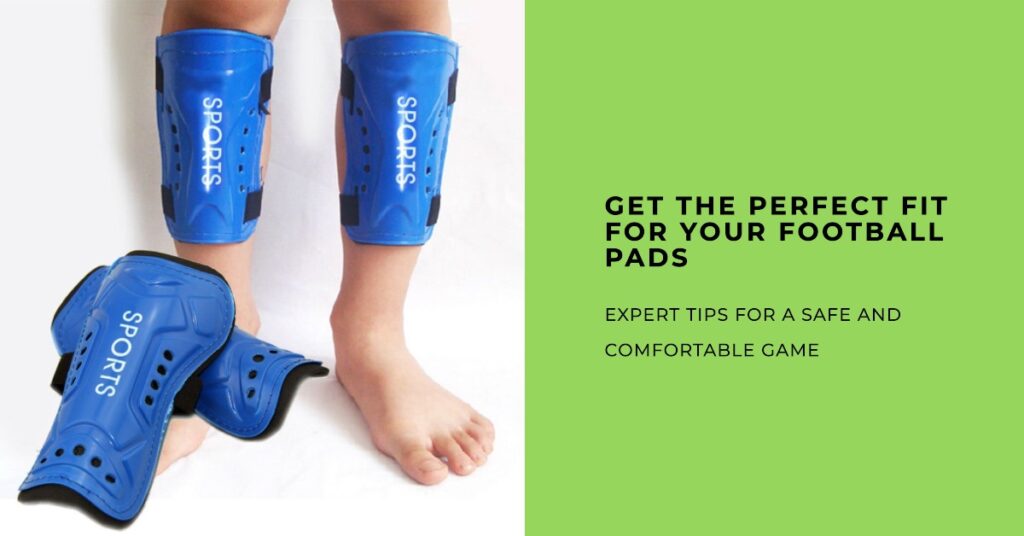Football pads should fit snugly and provide coverage over the sternum, front upper shoulders, and scapula. The proper fit ensures optimal protection and allows for unrestricted movement on the field.
We will discuss how football pads should fit and provide tips for achieving the correct fit for shoulder pads. Whether you are a beginner or an experienced player, understanding proper pad fit is essential for safety and performance. We will also explore different types of football pads and their features to help you make an informed decision when choosing the right gear.
Importance Of Properly Fitting Football Pads
Properly fitting football pads are crucial for both the safety and performance of players. Whether you are a professional or youth football player, having the right fit ensures maximum protection, and comfort, and enhances overall performance on the field. In this article, we will discuss the importance of properly fitting football pads in preventing injuries, enhancing performance, and ensuring comfort.
a. Preventing Injuries
One of the primary reasons for properly fitting football pads is to prevent injuries. When the pads are too loose, they fail to provide adequate protection, increasing the risk of injuries such as bruises, sprains, fractures, or even more severe injuries like concussions. On the other hand, pads that are too tight can restrict movement and hinder agility, making it more difficult to react quickly and safely during gameplay.
b. Enhancing Performance
Properly fitting football pads not only protect players but also enhance their performance on the field. Well-fitted pads allow players to move freely and comfortably without any restrictions. This allows for better agility, speed, and overall performance during gameplay. When the pads are secure and in the right position, players can focus on their techniques and skills, giving them a competitive edge.
c. Ensuring Comfort
Comfort is another key aspect of properly fitting football pads. Players spend hours on the field, so they must have gear that provides comfort throughout the game. Pads that are too tight can cause discomfort, chafing, and restrict blood flow. Conversely, loose pads can shift during play, causing distractions and reducing focus. By ensuring the pads fit snugly but comfortably, players can stay focused and perform at their best.
Overall, the importance of properly fitting football pads cannot be overstated. They are essential for preventing injuries, enhancing performance, and ensuring maximum comfort. Whether you are a seasoned player or just getting started, it’s important to invest time in finding the right fit for your football pads. By doing so, you can enjoy the game to its fullest while staying safe and performing at your peak.
Choosing The Right Size Football Pads
When it comes to football pads, one of the most crucial factors in ensuring maximum comfort and protection is finding the right size. Ill-fitting pads can hinder your performance on the field and increase the risk of injuries. Therefore, it is essential to measure yourself accurately and determine the appropriate size based on those measurements. In this article, we will guide you through the process of choosing the right size football pads, ensuring a perfect fit for optimal performance and safety.
a. Measuring For Accurate Fit
Before purchasing football pads, the first step is to measure yourself accurately using a measuring tape. This will help you determine the correct size based on your measurements. Here are the key areas to measure:
- Shoulder width: Stand up straight with your arms relaxed. Measure the distance between the bony points on the top of your shoulders.
- Chest circumference: Wrap the measuring tape around the fullest part of your chest, just below the armpits. Make sure the tape is snug but not too tight.
- Bicep circumference: Measure around the fullest part of your bicep, ensuring the tape is comfortably snug.
- Backplate length: This measurement is essential for determining the proper size backplate for your football pads. Measure the distance from the base of your neck to the desired position on your lower back.
b. Determining The Appropriate Size Based On Measurements
Once you have accurate measurements, it’s time to determine the appropriate size for your football pads. Manufacturers provide sizing charts that correlate measurements with pad sizes. Refer to these charts to find the pad size that aligns with your measurements. Keep in mind that different brands may have slight variations in sizings, so always refer to the specific manufacturer’s chart for accuracy.
When comparing your measurements to the sizing chart, consider the following:
- If your measurements fall between two sizes, it’s generally recommended to choose the larger size for a more comfortable fit.
- Take into account any additional layers or clothing you may wear underneath the pads. Allow room for these layers without compromising mobility or protection.
- Pay attention to any specific recommendations or guidelines provided by the manufacturer for each pad model.
Remember, the fit of your football pads is crucial for both comfort and protection. Properly fitted pads should sit snugly against your body without restricting movement or causing discomfort. It’s essential to try on pads and evaluate the fit before making a final decision. If possible, visit a nearby sporting goods store or consult with a knowledgeable professional to ensure you find the perfect fit.
By taking the time to measure yourself accurately and referring to manufacturer sizing charts, you can confidently choose the right size football pads that optimize your performance and protect you during gameplay.
Fitting Shoulder Pads
Properly fitting shoulder pads are essential for football players, as they provide crucial protection and support during gameplay. With the correct fit, shoulder pads can help absorb impact and reduce the risk of injury. Here are some guidelines for fitting shoulder pads to ensure optimal performance and safety:
a. Adjusting The Straps
One of the first steps in fitting shoulder pads is adjusting the straps. The straps should be tight enough to keep the pads securely in place, but not so tight that they restrict movement or cause discomfort. Start by loosening all the straps before putting on the pads. Then, slide the shoulder pads over your head and position them correctly on your shoulders.
Next, tighten the straps one by one to secure the pads in place. Pay attention to the fit around the chest, back, and shoulders. The straps should be snug but not overly restrictive. Make sure to adjust each strap evenly to maintain balance and even pressure distribution.
b. Checking Proper Coverage
Once the shoulder pads are secured, it’s important to check for proper coverage. The pads should cover the entire shoulder area, extending to the top of the shoulders and wrapping around the sides. There should be no exposed gaps between the pads and your body.
Additionally, the shoulder pad extensions (the sections that extend beyond the main pads) should provide adequate coverage for the upper arms and collarbone area. This ensures that these vulnerable areas are well-protected during intense gameplay.
c. Evaluating Mobility And Range Of Motion
While proper protection is essential, it’s also crucial to assess mobility and range of motion when fitting shoulder pads. Football players need to have the freedom to move their arms, twist their torso, and perform other essential movements without hindrance.
With the pads on, try moving your arms in different directions, raising and lowering them, and performing football-specific movements. Ensure that the shoulder pads do not restrict your range of motion or cause discomfort during these actions. Remember, you need to be agile and agile on the field.
By following these guidelines for fitting shoulder pads, football players can optimize their safety and performance during gameplay. Remember to periodically reassess the fit of your shoulder pads as your body may change over time or with weight loss/gain.
Fitting Helmet And Chin Strap
When it comes to playing football, ensuring the proper fit of your gear is crucial for both performance and safety. Among the most important pieces of equipment to consider are the helmet and chin strap. Selecting the right helmet size, checking helmet fit, and properly securing the chin strap are essential steps in ensuring optimal comfort and protection on the field.
a. Selecting The Right Helmet Size
Selecting a properly fitting helmet is the first step towards ensuring your safety on the football field. A helmet that is too large or too small can increase the risk of head injuries. To determine the correct size, it is recommended to measure the circumference of your head just above the eyebrows using a soft measuring tape. Use the following size chart as a guideline:
| Helmet Size | Head Circumference (in inches) |
|---|---|
| Small | 20 – 21 ½ |
| Medium | 21 ½ – 23 |
| Large | 23 – 24 ½ |
| X-Large | 24 ½ – 26 |
It’s important to note that this sizing chart may vary slightly depending on the helmet manufacturer. Always refer to the specific sizing information provided by each brand.
b. Checking Helmet Fit
Once you have selected the appropriate helmet size, it is crucial to ensure that it fits properly on your head. A secure and snug fit is essential for optimal protection. Here are a few key factors to consider when checking helmet fit:
- The helmet should sit level on your head, covering the forehead and not tilted forward or backward.
- The helmet’s crown pads should make direct contact with your head without any gaps or spaces.
- The cheek pads should press against your cheeks without causing discomfort.
- The chin strap should be secure and snug, keeping the helmet in place.
Remember to readjust the helmet’s padding and straps regularly to maintain a proper fit throughout the season, as head shapes can change over time.
c. Properly Securing Chin Strap
The chin strap plays a vital role in keeping your helmet securely in place during gameplay. Follow these steps to properly secure your chin strap:
- Position the chin cup centered on your chin, with the strap passing through the earholes of the helmet.
- Bring both ends of the strap together under your chin and secure them using the buckle or snap fasteners.
- Ensure that the strap is snug, keeping the helmet securely on your head without causing discomfort or inhibiting breathing.
- Test the tightness of the strap by opening your mouth wide; if the helmet moves excessively, readjust the strap accordingly.
Remember to check the chin strap’s condition regularly for any signs of wear and tear and replace it if necessary. A secure chin strap is vital to prevent the helmet from shifting during impact and to provide optimal protection.
By selecting the right helmet size, checking the fit, and properly securing the chin strap, you can ensure that your football gear offers the maximum level of comfort and protection, allowing you to focus on the game at hand. Prioritize your safety and make the necessary adjustments to your gear to optimize your performance on the field.
Evaluating Fit For Other Football Pads
When evaluating fit for other football pads, it’s important to ensure they are snug but not too tight, providing coverage over the sternum, upper shoulders, and scapula. Proper fitting is crucial for player safety and performance.
a. Chest Protector
When evaluating fthe it for a chest protector, it’s important to ensure that it provides adequate coverage and protection to the chest and vital organs. The chest protector should fit snugly and securely, without restricting movement or causing discomfort. Here are some key considerations when evaluating the fit of a chest protector:
- Check the length: The chest protector should cover the entire chest area and extend down to the lower ribcage. It should also provide coverage for the collarbone and upper abdomen.
- Secure straps: The chest protector should have adjustable straps that allow for a customized fit. These straps should be fastened tightly to ensure the protector stays in place during gameplay.
- Breathability: Look for a chest protector that is made with breathable materials to prevent excessive sweating and discomfort during intense physical activity.
- Range of motion: The chest protector should not restrict the player’s range of motion, especially when it comes to arm movement. The player should be able to comfortably raise their arms and perform various football-specific movements without feeling restricted.
b. Football Pants
Properly fitting football pants are essential for comfort, flexibility, and protection on the field. Here are some factors to evaluate when assessing the fit of football pants:
- Waistband fit: The waistband of the football pants should fit comfortably around the player’s waist, without being too loose or too tight. It should be secure enough to keep the pants in place without causing discomfort or impeding movement.
- Length: The length of the football pants should be appropriate for the player’s height. They should extend to just below the knee, offering sufficient coverage and protection.
- Flexibility: Football pants should be made of flexible materials that allow for a full range of motion. They should not restrict movements such as running, jumping, or tackling.
- Cushioning: Look for pants that have built-in padding or the option to insert pads. This helps to provide additional protection to vulnerable areas, such as the thighs and hips.
c. Football Girdle
A football girdle is designed to provide compression and support to the lower body, offering both comfort and protection. When evaluating the fit of a football girdle, consider the following:
- Snug compression: The girdle should fit snugly against the player’s skin, providing compression without being too tight or restrictive. This helps with muscle support and reduces the risk of muscle strains or fatigue.
- Flexibility: The material of the girdle should be stretchy and flexible, allowing for a full range of motion. This is essential for movements such as running, cutting, and jumping.
- Padded protection: Some football girdles come with built-in padding or the option to insert pads. Ensure that the padding aligns with the player’s specific need for protection, such as hip or thigh pads.
- Moisture-wicking: Look for a girdle that is made with moisture-wicking fabric to keep the player dry and comfortable during intense physical activity. This helps to prevent chafing and skin irritation.
Taking Care Of Football Pads
a. Cleaning And Maintenance Tips
To ensure your football pads maintain their performance and longevity, proper cleaning and maintenance are essential. Follow these tips to keep your pads in top condition:
- After each practice or game, wipe down your pads with a damp cloth to remove sweat, dirt, and odor.
- For a deeper clean, combine mild detergent with water and gently scrub your pads using a soft-bristled brush.
- Avoid submerging your pads in water, as it can damage the padding material. Instead, focus on sspot-cleaningany stains or buildup.
- Allow your pads to air dry completely before storing them to prevent the growth of mold and bacteria.
- Regularly inspect your pads for any signs of wear and tear, such as loose stitching or damaged padding. Replace any worn-out parts immediately.
b. When To Replace Pads
Football pads are designed to absorb impact and protect players against injuries. However, over time, the padding can become compressed and lose its effectiveness. Keep an eye out for these signs indicating it’s time to replace your pads:
- If the padding feels significantly thinner or less cushioned than when you first purchased them.
- The straps or closures are damaged or no longer secure the pads properly.
- There are visible tears, cracks, or holes in the padding or outer shell of the pads.
- Your pads no longer fit snugly against your body, causing them to shift or slide during gameplay.
c. Storing Pads Properly
Properly storing your football pads will ensure they stay in good condition and are ready for the next season. Here are some tips for storing your pads:
- Ensure your pads are clean and dry before storing them to prevent mold and odor buildup.
- Avoid direct sunlight, excessive heat, or humidity when choosing a storage location, as these conditions can degrade the materials.
- If possible, store your pads in a cool, dry area, such as a closet or equipment bag.
- Do not stack heavy items on top of your pads, as this can cause them to lose their shape and protective capabilities.
- Periodically check on your stored pads to ensure they remain in good condition and are not being damaged by pests or other environmental factors.
Frequently Asked Questions
a. How Are Football Pads Supposed To Fit?
Football pads should be snug and properly positioned on the player’s body. The shoulder pads should cover the sternum, the upper shoulders, and the scapula. Using a measuring tape, measure the width of the player’s back from the edge of the left shoulder to the edge of the right shoulder to determine the correct size.
b. Should Football Pads Be Tight?
Football pads should fit snugly to provide proper protection and prevent movement while playing. They should cover the sternum, upper shoulders, and scapula of the player. Measure the width of the player’s back using a soft measuring tape to determine the right size.
c. Where Should Football Pads Sit?
Football pads should sit in a way that covers the sternum, front upper shoulders, and scapula of the player. It is important to ensure proper coverage and protection for the player. Measure the width of the player’s back from the edge of the left shoulder to the edge of the right shoulder for proper fitting.
d. How Should Football Gear Fit?
Football gear should fit properly to ensure safety and optimal performance. Shoulder pads should cover the sternum, upper shoulders, and scapula. Measure the width of the player’s back with a soft measuring tape. Find the right size using a football shoulder pad size chart.
Proper fit is essential for maximum protection.
Final Words
Properly fitting football pads are essential for player safety and performance on the field. Whether it’s shoulder pads or a helmet, finding the right fit is crucial. Shoulder pads should cover the sternum, front upper shoulders, and scapula for optimal protection.
To ensure a proper fit, measure the width of the player’s back using a soft measuring tape. Referencing size charts can also help in selecting the appropriate pads. Remember, a well-fitted pad should provide comfort and unrestricted movement while ensuring maximum protection.
Prioritize safety and performance by investing time in fitting football pads accurately.
While fitting your football pads correctly is crucial for performance and safety, maintaining them is equally important. To ensure your gear remains in top condition, check out our comprehensive guide, ‘How to Clean Football Pads?‘ This resource provides step-by-step instructions on cleaning and preserving your football pads, extending their life and effectiveness on the field.






